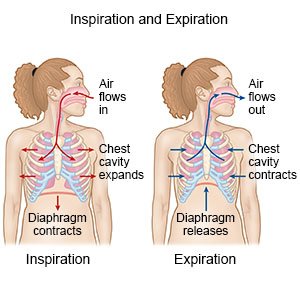How your Lungs Work
Medically reviewed by Drugs.com. Last updated on Aug 4, 2025.
What do I need to know about my lungs?
Your lungs are part of the respiratory system. The respiratory system contains organs and tissues that help you breathe. When you breathe in (inhale), your lungs remove oxygen from the air. The oxygen is moved into your blood and goes into your heart. Your heart then pumps the oxygen to the rest of your body. When you breathe out (exhale), your lungs remove waste gas (carbon dioxide) from your body.
 |
What are the parts of the lung?
- Bronchial tubes branch from your windpipe into your left and right lungs. Bronchial tubes branch into smaller tubes (bronchioles) and end as alveoli.
- Alveoli are small air sacs that have capillaries within their walls. Capillaries are small blood vessels where the exchange of oxygen and carbon dioxide happen.
- Lobes are the sections of your lungs. Your right lung has 3 lobes and your left lung has 2 lobes. Your left lung is smaller to make room for your heart.
- Pleura is the membrane that covers your lungs and keeps them from touching your chest wall.
- Cilia are very small hair-like tissues that line the bronchial tubes. They wave back and forth and carry mucus up out of your lungs into your throat. Once in your throat, the mucus can be coughed out or swallowed.
Related medications
What other organs and tissues are used in breathing?
- Air comes into your body through your nose or mouth and travels down your windpipe.
- The muscles between your ribs allow your ribs to expand and contract slightly. This gives your lungs room to fill with air and deflate.
- Your diaphragm is a muscle that separates your chest and abdominal cavity. Your diaphragm is just below your lungs. As your diaphragm moves down, your lungs expand.
- Abdominal muscles help you breathe out when you are breathing fast. During exercise, your abdominal muscles push your diaphragm against your lungs more often. This pushes air out of your lungs faster and more often.
- Neck and shoulder muscles may help expand the lungs if you have a lung condition, such as emphysema. Other muscles have to help in emphysema because the diaphragm does not work properly.
What can I do to decrease my risk for lung problems?
- Do not smoke. Smoking can make your airways narrow. Narrow airways can make breathing difficult. Smoking can cause long-term swelling of your lungs and destroy lung tissue. Smoking also increases your risk for cancer. If you smoke, it is never too late to quit. Ask for information if you need help quitting. E-cigarettes or smokeless tobacco still contain nicotine. Talk to your healthcare provider before you use these products.
- Avoid risks of toxins in the air. Toxins include secondhand smoke, air pollution, chemicals, and radon. Toxins can cause lung disease or make your lung disease worse. Test your house for radon. Make your house and car smoke-free areas. Do not exercise outside on bad air days.
- Prevent infection. Respiratory infections and colds may become serious for a person who has a lung condition. Wash your hands often with soap and water. Avoid crowds during cold and flu seasons. Get a yearly flu vaccine. Ask your healthcare provider if you need a pneumonia vaccine.
- Follow up with your healthcare provider regularly. Your healthcare provider will listen to your lungs. Regular follow-up visits can help your healthcare provider find a lung disease before it becomes serious.
Care Agreement
You have the right to help plan your care. Learn about your health condition and how it may be treated. Discuss treatment options with your healthcare providers to decide what care you want to receive. You always have the right to refuse treatment. The above information is an educational aid only. It is not intended as medical advice for individual conditions or treatments. Talk to your doctor, nurse or pharmacist before following any medical regimen to see if it is safe and effective for you.© Copyright Merative 2025 Information is for End User's use only and may not be sold, redistributed or otherwise used for commercial purposes.
Further information
Always consult your healthcare provider to ensure the information displayed on this page applies to your personal circumstances.
